Items
In item set
HREU 1930s-1940s
-
 Jonnie Rankin Interview [Parts 2 and 3] In Part 2 of 3, Johnnie Rankin discusses the position of women within the Boilermakers Union and the types of jobs she worked at the shipyard. She also discusses childcare, equal pay, and the existence of issues specific to women. She talks about what she learned from the trade unions, and how working changed her life. Finally, she discusses working in restaurants and approaching the Hotel and Restaurant Employees Union. In Part 3 of 3, Johnnie Rankin discusses organizing in restaurants, going to business school, the 1946 strike and the role of women within it, the creation of the Labour Theatre Guild, and the political impact working during the war had on her.
Jonnie Rankin Interview [Parts 2 and 3] In Part 2 of 3, Johnnie Rankin discusses the position of women within the Boilermakers Union and the types of jobs she worked at the shipyard. She also discusses childcare, equal pay, and the existence of issues specific to women. She talks about what she learned from the trade unions, and how working changed her life. Finally, she discusses working in restaurants and approaching the Hotel and Restaurant Employees Union. In Part 3 of 3, Johnnie Rankin discusses organizing in restaurants, going to business school, the 1946 strike and the role of women within it, the creation of the Labour Theatre Guild, and the political impact working during the war had on her. -
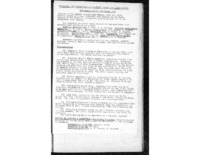 [CVA VDTLC 1944 Jul-Dec] Minutes of the Vancouver and New Westminster District Trades and Labor Council. Researcher scan of microfilm reel, part of City of Vancouver Archive Fonds AM307, Vancouver and District Trades and Labour Council fonds : 1889-1961.
[CVA VDTLC 1944 Jul-Dec] Minutes of the Vancouver and New Westminster District Trades and Labor Council. Researcher scan of microfilm reel, part of City of Vancouver Archive Fonds AM307, Vancouver and District Trades and Labour Council fonds : 1889-1961. -
 Daisy Brown Interview Daisy Brown was the office manager of the Hotel, and Restauarant Employees Union Local 28. She discusses her years with the Hotel and Restaurant Employees Union and building service union’s joint campaign to organize Vancouver hotels 1946-1947; the high number of single women parents and deserted wives working in the industry; the weakness of the union in comparison to industrial or skilled craft unions due to isolation of the workers; the difficulties the transient nature of the work and continuous shifts posed for organizers; issues of overtime, shift changes, uniforms, seniority; establishing the 40-hour work week; The Only Fish and Chips and Love’s Cafe, Vancouver; deposing the local HREU leadership in 1947 barring them from the office and membership in the union because of their left leanings.
Daisy Brown Interview Daisy Brown was the office manager of the Hotel, and Restauarant Employees Union Local 28. She discusses her years with the Hotel and Restaurant Employees Union and building service union’s joint campaign to organize Vancouver hotels 1946-1947; the high number of single women parents and deserted wives working in the industry; the weakness of the union in comparison to industrial or skilled craft unions due to isolation of the workers; the difficulties the transient nature of the work and continuous shifts posed for organizers; issues of overtime, shift changes, uniforms, seniority; establishing the 40-hour work week; The Only Fish and Chips and Love’s Cafe, Vancouver; deposing the local HREU leadership in 1947 barring them from the office and membership in the union because of their left leanings. -
 Elizabeth Wilson interview Audio and transcript of Sara Diamond's interview with Elizabeth Wilson.
Elizabeth Wilson interview Audio and transcript of Sara Diamond's interview with Elizabeth Wilson. -
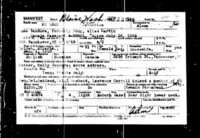 U.S., Border Crossings from Canada to U.S., 1895-1960 for Catherine McLeod This item documents the maiden and married names, and alias, Kay Martin, of a spokesperson for the White waitresses working in Chinatown, Vancouver, cafes who were forced out of their jobs by the City of Vancouver and the Vancouver Police Chief in 1937.
U.S., Border Crossings from Canada to U.S., 1895-1960 for Catherine McLeod This item documents the maiden and married names, and alias, Kay Martin, of a spokesperson for the White waitresses working in Chinatown, Vancouver, cafes who were forced out of their jobs by the City of Vancouver and the Vancouver Police Chief in 1937. -
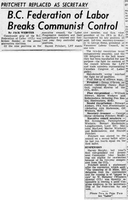 BC Federation of Labour Breaks Communist Control At the annual convention elections, 5 of 9 labor progressive members and their allies on the executive council, lost their positions and the Canadian Congress of Labour (CCL) majority.
BC Federation of Labour Breaks Communist Control At the annual convention elections, 5 of 9 labor progressive members and their allies on the executive council, lost their positions and the Canadian Congress of Labour (CCL) majority. -
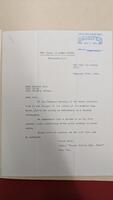 Correspondence between the League of Women Voters and the Vancouver City Clerk_17 Feb 1943 - 17 Mar 1943: White waitresses in Chinatown The League of Women Voters allege white women are working in Chinatown counter to legislation. The City Clerk replies with an interpretation of policies instituted in 1937/1938 which suggests the City may be moving away from their earlier position.
Correspondence between the League of Women Voters and the Vancouver City Clerk_17 Feb 1943 - 17 Mar 1943: White waitresses in Chinatown The League of Women Voters allege white women are working in Chinatown counter to legislation. The City Clerk replies with an interpretation of policies instituted in 1937/1938 which suggests the City may be moving away from their earlier position. -
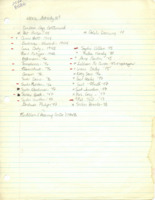 Researcher notes: Hotel and Restaurant Employees Union Local 28 activities Notes by researcher Sara Diamond from her late 1970s-early 1980s Women's Labour History Project. Diamond's notes are written in cursive and assembled in three parts. Does not always follow chronological order. 1930s-1940s
Researcher notes: Hotel and Restaurant Employees Union Local 28 activities Notes by researcher Sara Diamond from her late 1970s-early 1980s Women's Labour History Project. Diamond's notes are written in cursive and assembled in three parts. Does not always follow chronological order. 1930s-1940s -
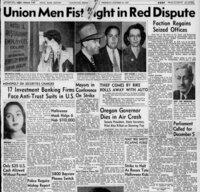 Union Men In Fistfight in Red Dispute: Faction regains seized offices International Union reps expell alleged Communist officers of HREU Local 28 from the headquarters. These included Emily Watts, local union president and May Ansell, local Businessness Agent. Vancouver Sun October 30, 1947
Union Men In Fistfight in Red Dispute: Faction regains seized offices International Union reps expell alleged Communist officers of HREU Local 28 from the headquarters. These included Emily Watts, local union president and May Ansell, local Businessness Agent. Vancouver Sun October 30, 1947 -
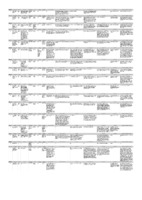 Case Study 1: Oral Histories Research document A thematic guide for the Women's Labour History Project oral histories. This work is ongoing. As of March 2024, we have drawn on oral histories from VIVO Media Arts Centre, SFU Archives, and newspaper interviews . We will soon be working on additions from other archives, like the BC Labour Heritage Centre. This multi-sheet xls spreadsheet includes (1) Object metadata for all interviews; (2) Interviewees biographical details; and (3) Research notes: select excerpts from the interview(s) and details related to our research questions (one sheet per interviewee) ID structure (1) Each interviewee is assigned a letter which is their "Subject ID" (A,B,C, etc.) (2) Each Object (research resource) is assigned an "Object ID" : a combination of the "Subject ID" and a number assigned to delineate each research resource (ie A1, A2, A3, etc). (3) Individual interviewees research sheet is identified using the individual's Subject ID followed by a colon and their surname (ie, A: Fawcett) About our Interviewee Biography sheet Drawing on publicly available resources and implementing genealogical strategies and proof standards, Knights expanded the biographies of the oral history participants. This assisted the researchers with clarifying timelines, locations, and confirming identifies. This latter step was required to ensure that we were researching the correct individual. The women regularly went by nicknames, middle names, maiden names if married, divorced surnames if single, Mrs or Miss irrespective of their actual marital status. It also gives insight into the way waitresses shifted marital status for protection, anonymity, or hirability. The biographic and demographic material also informs the interviewees own statements on why they became involved in union activity or activist movements.
Case Study 1: Oral Histories Research document A thematic guide for the Women's Labour History Project oral histories. This work is ongoing. As of March 2024, we have drawn on oral histories from VIVO Media Arts Centre, SFU Archives, and newspaper interviews . We will soon be working on additions from other archives, like the BC Labour Heritage Centre. This multi-sheet xls spreadsheet includes (1) Object metadata for all interviews; (2) Interviewees biographical details; and (3) Research notes: select excerpts from the interview(s) and details related to our research questions (one sheet per interviewee) ID structure (1) Each interviewee is assigned a letter which is their "Subject ID" (A,B,C, etc.) (2) Each Object (research resource) is assigned an "Object ID" : a combination of the "Subject ID" and a number assigned to delineate each research resource (ie A1, A2, A3, etc). (3) Individual interviewees research sheet is identified using the individual's Subject ID followed by a colon and their surname (ie, A: Fawcett) About our Interviewee Biography sheet Drawing on publicly available resources and implementing genealogical strategies and proof standards, Knights expanded the biographies of the oral history participants. This assisted the researchers with clarifying timelines, locations, and confirming identifies. This latter step was required to ensure that we were researching the correct individual. The women regularly went by nicknames, middle names, maiden names if married, divorced surnames if single, Mrs or Miss irrespective of their actual marital status. It also gives insight into the way waitresses shifted marital status for protection, anonymity, or hirability. The biographic and demographic material also informs the interviewees own statements on why they became involved in union activity or activist movements. -
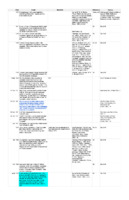 CS1 White Waitresses in Chinatown_Timeline of key events (In progress) In progress: timeline of key events related to the issue of of White waitresses working in Chinatown, Vancouver, cafes and restaurants, and the subsequent implication and application of municipal and provincial regulations and laws. The final timeline will feature the actions by the waitresses implicated, political allies, and the Hotel Restaurant and Employees Union Local 28. Related unpublished resource include demographic and biographical data of the waitresses. Contact the researcher for access.
CS1 White Waitresses in Chinatown_Timeline of key events (In progress) In progress: timeline of key events related to the issue of of White waitresses working in Chinatown, Vancouver, cafes and restaurants, and the subsequent implication and application of municipal and provincial regulations and laws. The final timeline will feature the actions by the waitresses implicated, political allies, and the Hotel Restaurant and Employees Union Local 28. Related unpublished resource include demographic and biographical data of the waitresses. Contact the researcher for access. -
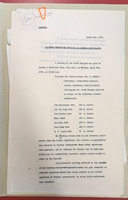 City of Vancouver Council Meeting Minutes, April 9, 1937. Vancouver City Mayor George C. Miller, Corporation Council, License Inspector, Surperintendent Darling, Mr. Denis Murphy on behalf of 7 Chinese-owned restaurants met to discuss "certain irregularities [that] have occured in Chinese restaurants where white waitresses were employed.
City of Vancouver Council Meeting Minutes, April 9, 1937. Vancouver City Mayor George C. Miller, Corporation Council, License Inspector, Surperintendent Darling, Mr. Denis Murphy on behalf of 7 Chinese-owned restaurants met to discuss "certain irregularities [that] have occured in Chinese restaurants where white waitresses were employed. -
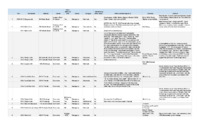 Vancouver White Help Restaurants: Newspaper ads and promotional writing (1929-1949) Survey of newspaper want ads, commercials, and promotional writing with mentions of "white help", "white help only", "white cooks". Includes union status, other descriptive language, owners names and bios. While multiple search strategies were employed on newspapers.com this does not claim to be a complete record. Some restaurants felt the promotion of their "white help only" status was a selling point for clients. 1/3 of restaurants found in this scan were HREU members.
Vancouver White Help Restaurants: Newspaper ads and promotional writing (1929-1949) Survey of newspaper want ads, commercials, and promotional writing with mentions of "white help", "white help only", "white cooks". Includes union status, other descriptive language, owners names and bios. While multiple search strategies were employed on newspapers.com this does not claim to be a complete record. Some restaurants felt the promotion of their "white help only" status was a selling point for clients. 1/3 of restaurants found in this scan were HREU members. -
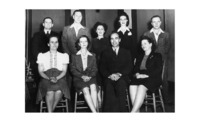 Executive of HREU Local 28 c.1947 SD_WLHP_MM3_006 Executive of H.R.E.U. Local 28 elected June 1947 [serving 1947-1948]. [Back row from left] Jimmy Lyons, Trustee; Bob Annola, Trustee; Margaret Shelton, Chairman [sic] of Education and Publicity; Gertrude Philip, Chairman of Social Committee; Roy Moore, Inspector. [Front row from left] Babella [Isabella] Beck, Recording Secretary; Emily Watts, President; Bob Williams, Vice President; May Ansell [Leniczek][Martin] , Secretary Treasurer and Business Agent.
Executive of HREU Local 28 c.1947 SD_WLHP_MM3_006 Executive of H.R.E.U. Local 28 elected June 1947 [serving 1947-1948]. [Back row from left] Jimmy Lyons, Trustee; Bob Annola, Trustee; Margaret Shelton, Chairman [sic] of Education and Publicity; Gertrude Philip, Chairman of Social Committee; Roy Moore, Inspector. [Front row from left] Babella [Isabella] Beck, Recording Secretary; Emily Watts, President; Bob Williams, Vice President; May Ansell [Leniczek][Martin] , Secretary Treasurer and Business Agent. -
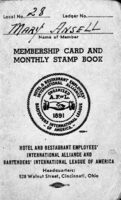 May Ansell [Martin] Member card and monthly stamp book Membership Card and Monthly Stamp Book for May Ansell [Martin], Hotel & Restaurant Employees' International Alliance and Bartenders League of America.
May Ansell [Martin] Member card and monthly stamp book Membership Card and Monthly Stamp Book for May Ansell [Martin], Hotel & Restaurant Employees' International Alliance and Bartenders League of America. -
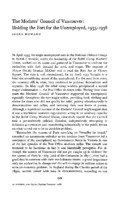 The Mothers' Council of Vancouver: Holding the Fort for the Unemployed, 1935-1938. An article document The Mothers' Council of Vancouver history and their work with the unemployed 1935-1938. Author Irene Howard.
The Mothers' Council of Vancouver: Holding the Fort for the Unemployed, 1935-1938. An article document The Mothers' Council of Vancouver history and their work with the unemployed 1935-1938. Author Irene Howard. -
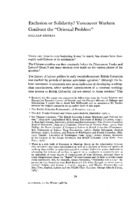 Exclusion or Solidarity:Vancouver Workers Confront the Oriental Problem Exclusion or Solidarity:Vancouver Workers Confront the Oriental Problem by author Gillian Creese. Examing the history of labour politics in early twentieth-century British Columbia, a period marked by periods of intense anti-Asian agitation and racist legislation. "Although the la bour movement is commonly seen as an indication of developing workingclass consciousness, white workers' consciousness of a common workingclass interest in British Columbia did not extend to Asian workers."
Exclusion or Solidarity:Vancouver Workers Confront the Oriental Problem Exclusion or Solidarity:Vancouver Workers Confront the Oriental Problem by author Gillian Creese. Examing the history of labour politics in early twentieth-century British Columbia, a period marked by periods of intense anti-Asian agitation and racist legislation. "Although the la bour movement is commonly seen as an indication of developing workingclass consciousness, white workers' consciousness of a common workingclass interest in British Columbia did not extend to Asian workers." -
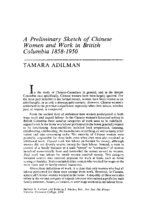 A Preliminary Sketch of Chinese Women and Work in British Columbia 1858-1950. A Preliminary Sketch of Chinese Women and Work in British Columbia 1858-1950 by Tamara Adilman.
A Preliminary Sketch of Chinese Women and Work in British Columbia 1858-1950. A Preliminary Sketch of Chinese Women and Work in British Columbia 1858-1950 by Tamara Adilman. -
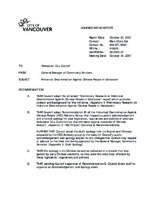 Historical discrimination against Chinese people in Vancouver A report presented to Vancouver City Council by the General Manager of Community Services on Oct 20, 2017. The report outlines the evidence of historical discrimination against Chinese people in Vancouver.
Historical discrimination against Chinese people in Vancouver A report presented to Vancouver City Council by the General Manager of Community Services on Oct 20, 2017. The report outlines the evidence of historical discrimination against Chinese people in Vancouver. -
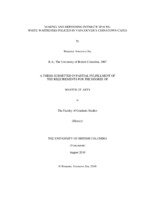 Making and defending intimate spaces: White waitresses policed in Vancouver's Chinatown cafes. Sia's thesis looks at the campaign by the Mayor and VPD against white waitresses working at Chinese-owned cafes in Chinatown that eventually led to protests by the waitresses, claims of immorality, cancelled business and an eventual settlement that saw the women fired from their jobs during the depression. licences MA Thesis, UBC 2010 fall. Rosanne Sia.
Making and defending intimate spaces: White waitresses policed in Vancouver's Chinatown cafes. Sia's thesis looks at the campaign by the Mayor and VPD against white waitresses working at Chinese-owned cafes in Chinatown that eventually led to protests by the waitresses, claims of immorality, cancelled business and an eventual settlement that saw the women fired from their jobs during the depression. licences MA Thesis, UBC 2010 fall. Rosanne Sia. -
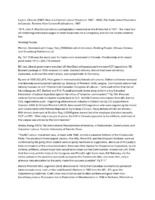 Researcher Notes on various Labour History sources. 1930s. 1940s. Sara Diamond's research notes from various sources. Good resource for communism and unions.
Researcher Notes on various Labour History sources. 1930s. 1940s. Sara Diamond's research notes from various sources. Good resource for communism and unions. -
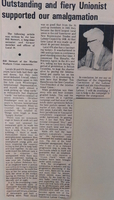 Outstanding and fiery unionist supported our amalgamation A reprint of an article by unionist William "Bill" Stewart on the challenges of organizing, published in commemoration of the amalgamation of Hotel, Restaurant and Employees Union Locals 676 an 28.
Outstanding and fiery unionist supported our amalgamation A reprint of an article by unionist William "Bill" Stewart on the challenges of organizing, published in commemoration of the amalgamation of Hotel, Restaurant and Employees Union Locals 676 an 28. -
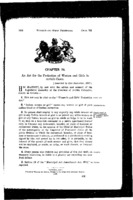 Women and Girls' Protection Act, Chapter 76 Women and Girls' Protection Act, Chapter 76, 1923
Women and Girls' Protection Act, Chapter 76 Women and Girls' Protection Act, Chapter 76, 1923 -
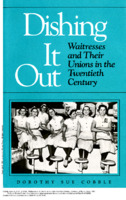 Dishing it Out: Waitresses and their Unions in the Twentieth Century Back when SOS or Adam and Eve on a raft were things to order if youwere hungry but a little short on time and money, nearly one-fourth of all waitresses belonged to unions. By the time their movement peaked in the 1940s and 1950s, the women had developed a distinctive form of working-class feminism, simultaneously pushing for equal rights and pay and affirming their need for special protections. Dorothy Sue Cobble shows how sexual and racial segregation persistedin wait work, but she rejects the idea that this was caused byemployers' actions or the exclusionary policies of male trade unionists.Dishing It Out contends that the success of waitress unionism wasdue to several factors: waitresses, for the most part, had nontraditionalfamily backgrounds, and most were primary wage-earners. Theirclose-knit occupational community and sex-separate union encouragedfemale assertiveness and a decidedly unromantic view of men andmarriage. Cobble skillfully combines oral interviews and extensivearchival records to show how waitresses adopted the basic tenets ofmale-dominated craft unions but rejected other aspects of male unionculture. The result is a book that will expand our understanding offeminism and unionism by including the gender consciousperspectives of working women. [Source: UI Press]
Dishing it Out: Waitresses and their Unions in the Twentieth Century Back when SOS or Adam and Eve on a raft were things to order if youwere hungry but a little short on time and money, nearly one-fourth of all waitresses belonged to unions. By the time their movement peaked in the 1940s and 1950s, the women had developed a distinctive form of working-class feminism, simultaneously pushing for equal rights and pay and affirming their need for special protections. Dorothy Sue Cobble shows how sexual and racial segregation persistedin wait work, but she rejects the idea that this was caused byemployers' actions or the exclusionary policies of male trade unionists.Dishing It Out contends that the success of waitress unionism wasdue to several factors: waitresses, for the most part, had nontraditionalfamily backgrounds, and most were primary wage-earners. Theirclose-knit occupational community and sex-separate union encouragedfemale assertiveness and a decidedly unromantic view of men andmarriage. Cobble skillfully combines oral interviews and extensivearchival records to show how waitresses adopted the basic tenets ofmale-dominated craft unions but rejected other aspects of male unionculture. The result is a book that will expand our understanding offeminism and unionism by including the gender consciousperspectives of working women. [Source: UI Press] -
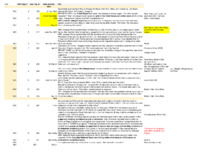 CVA VDTLC Minutes 1930-1948: Researchers Notes Researcher notes taken from Vancouver District Labour Council Minutes 1930-1948.
CVA VDTLC Minutes 1930-1948: Researchers Notes Researcher notes taken from Vancouver District Labour Council Minutes 1930-1948.
